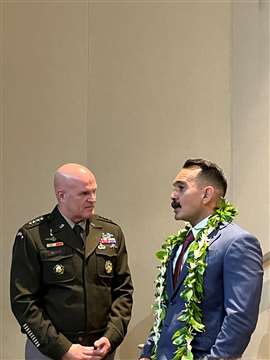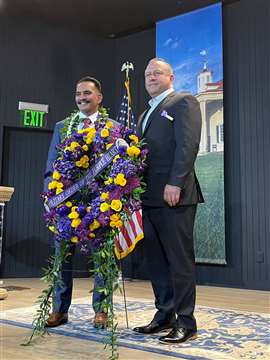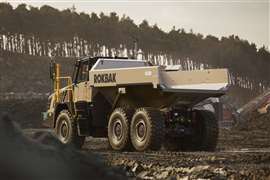Read this article in Français Deutsch Italiano Português Español
From combat zones to worksites: a US Marine’s path to construction leadership
11 November 2025
In Iraq, Kellen Concepcion saw neighbourhoods shattered by war start to rise again. Two decades later, the former US Marine heads Semper Fi Rebar, a California subcontractor built on the same principle of building and resilience.
It is not a common path into the construction industry, but one that has shaped Concepcion’s career and outlook.
He shared his story with Construction Briefing as an example of how service members can transition into civilian careers, and how the industry can find new sources of skilled labour.
Early life and military service
Born and raised in Hawaii, Concepcion joined the US Marine Corps straight out of high school in 2002. A talented baseball player, he considered continuing with athletics at a community college but decided against it.
 In August, Concepcion was honoured at George Washington’s Mount Vernon Mansion in Virginia during a Purple Heart commemoration ceremony (Image supplied)
In August, Concepcion was honoured at George Washington’s Mount Vernon Mansion in Virginia during a Purple Heart commemoration ceremony (Image supplied)
“I just didn’t want to do the school thing,” he said.
Within weeks of enlisting, he was deployed to Kuwait and then Iraq as part of the initial US invasion.
“Two weeks [after arriving in the Middle East], we crossed the line of departure. That’s when the war started,” he recalled.
Over the next several years, he completed three tours with the Marines. He served in Baghdad, near the ruins of ancient Babylon south of the capital, and in Fusaybah, a Syrian border city, during the Battle of Fallujah.
“It was a very tough deployment,” he said.
But he also remembers the human side of those tours.
“Every time we went out, I’d have my guys carry a soccer ball or school supplies. If we saw kids in the street, we’d hand them out. Sometimes we’d stop and play with them. I wanted them to know we were there to help,” he said
On his third tour, he returned to the same city he had patrolled earlier, this time witnessing the early reconstruction efforts.
“Seeing where this empty lot was, and now there’s a new house with kids running around again, it played a part in my decision later to get into construction,” he said.
Looking for a new mission
After leaving active duty, Concepcion joined the Ironworkers Union in Hawaii with the help of a family friend; his first introduction to the trades.
But his transition into civilian life was interrupted by a deployment with the Hawaii Army National Guard, again to Iraq.
During that deployment, his convoy struck an improvised explosive device (IED). He suffered burns and lung damage and was flown first to Germany, then to a military burn unit in Texas.
“I was there for about three months healing,” he said. “Once they released me, I went back home to Hawaii and that’s when pretty much everything hit rock bottom, struggling physically and mentally.”
To reset, he moved to California. He took odd jobs, including at a wholesale retailer, before his then-girlfriend – now his wife – encouraged him to return to the trades.
A brotherhood in ironwork
It was just the push he needed. Back in California, Concepcion worked under foremen who, over time, became close friends and mentors.
Restarting as a first-period apprentice, Concepcion worked his way through the four-year programme to journeyman.
Along the way he found camaraderie that reminded him of his military service.
“Even though I was an outsider from Hawaii and most of the crew spoke Spanish, they took me in,” he said. “It helped me get out of that little rut I was in.”
The culture of the trade was familiar.
“It’s a hard trade, a bunch of knuckleheads talking trash to each other, but that’s what I liked about it,” he said. “It just reminded me of the Marine Corps and the Army, everybody’s having fun but still getting the job done.”
That environment convinced him he could do more than work the field. Through the Ironworkers’ IMPACT organisation, he attended a business development course led by Cindy Quiroz, Program Administrator at IMPACT, who specialises in contractor training.
With her guidance, he launched Semper Fi Rebar in 2016.
Building Semper Fi Rebar
Years later, Quiroz reconnected with Concepcion and introduced him to Martinez Steel. Together they entered the Small Business Administration (SBA) mentor-protégé programme, which allowed Concepcion, through Semper Fi Rebar, to learn while delivering on large-scale contracts.
Through the partnership, the company gained traction on high-profile projects: American Airlines’ terminal redevelopment at Los Angeles International Airport, SoFi Stadium in Inglewood, and the Intuit Dome, the future home of the NBA’s Los Angeles Clippers. Work also came with large contractors such as Hensel Phelps, Flatiron, and Largo Concrete.
One project that stood out was not commercial but charitable: contributing labour to build a home for a disabled Green Beret veteran through the Jared Allen Foundation. “That’s probably one of my favourite projects,” Concepcion said.
Today, Semper Fi continues to collaborate with Martinez but is increasingly bidding projects independently. It is also looking to expand beyond California.
“In the next few years we want to gain a foothold in the Maryland, DC, Virginia area,” he said, noting he had recently met with Ironworkers Local 5 in Washington, DC.
Leadership and lessons learned
For Concepcion, the transition from field work to boardrooms has been as much about mindset as skill.
“Walking into these meetings, I’d feel like I didn’t belong. These guys have their college degrees, running multimillion-dollar companies. At first, I’d just stay quiet and let Cindy take the role. But over time, I realised I do belong at the table.”
That growth came in part from his willingness to ask questions and take advice (whether from his wife, Quiroz or others in the industry), something he says is not always expected in construction.
“In the trades, people think you’re supposed to be the alpha male. If you ask questions, you’re not an alpha male anymore,” he explained. “But for me, I’ve never had a problem asking for help. If you don’t ask, you’ll never learn.”
That openness extended to conversations about his military service.
“I do have PTSD, I do have TBI [traumatic brain injury], but it doesn’t affect me as much as others because I’m able to talk about it,” he said.
The reason why? Communication.
“It’s infectious. Once I opened up, the guys I worked with started opening up as well.”
An honour for service, a call to action
 In August, Concepcion was honoured at George Washington’s Mount Vernon Mansion in Virginia during a Purple Heart commemoration ceremony (Image supplied)
In August, Concepcion was honoured at George Washington’s Mount Vernon Mansion in Virginia during a Purple Heart commemoration ceremony (Image supplied)
In August, Concepcion was honoured at George Washington’s Mount Vernon Mansion in Virginia during a Purple Heart commemoration ceremony, recognising his sacrifice as a combat veteran of Iraq.
Honoured for his physical and mental sacrifice, Concepcion is now working to build his reputation in a different arena – the construction industry.
“Ironworking gave me more than a trade, it gave me purpose again,” Concepcion said. “I’m building not just structures, but a future; for myself, for my family, and for other veterans.”
Leaders in the industry said his journey reflects the resilience that veterans bring to the trades.
“He’s not only rebuilt his own life, he’s now building careers for others and strengthening our industry,” said Eric Dean, general president of the International Association of Bridge, Structural, Ornamental and Reinforcing Iron Workers.
With the US construction sector still facing shortages of skilled labour, Concepcion hopes his story shows other veterans and young workers that there is a place for them in the industry.
“When service members get out, we have a hard time transitioning,” he said. “But finding the right career, where you still have that camaraderie and that purpose, helps a lot.
“For me, that’s what construction has been.”
STAY CONNECTED


Receive the information you need when you need it through our world-leading magazines, newsletters and daily briefings.
CONNECT WITH THE TEAM










